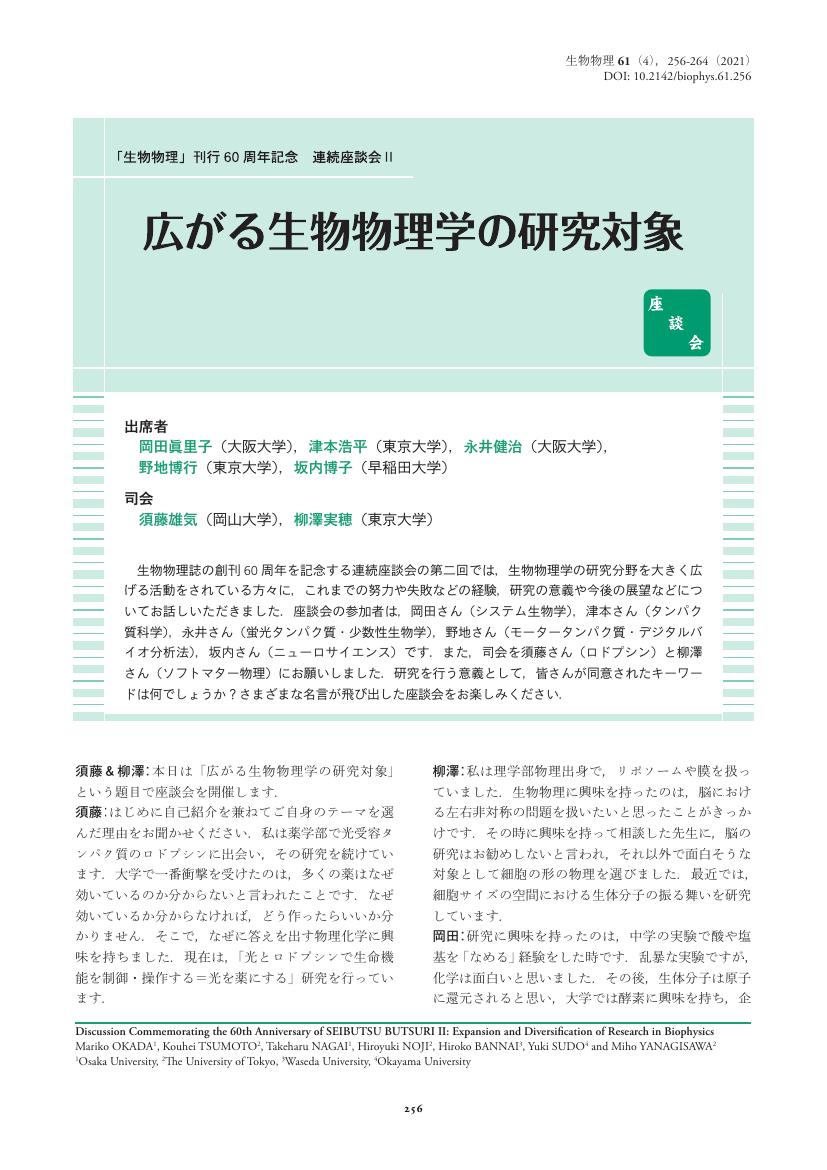6 0 0 0 OA 広がる生物物理学の研究対象
- 著者
- 岡田 眞里子 津本 浩平 永井 健治 野地 博行 坂内 博子 須藤 雄気 柳澤 実穂
- 出版者
- 一般社団法人 日本生物物理学会
- 雑誌
- 生物物理 (ISSN:05824052)
- 巻号頁・発行日
- vol.61, no.4, pp.256-264, 2021 (Released:2021-07-30)
5 0 0 0 少数性生物学ー個と多数の狭間が織りなす生命現象の探求ー
- 著者
- 永井 健治
- 出版者
- 大阪大学
- 雑誌
- 新学術領域研究(研究領域提案型)
- 巻号頁・発行日
- 2016-04-01
【5年間の成果を総括した書籍「少数性生物学」の出版】領域研究にて得た研究成果をまとめた書籍「少数性生物学」(日本評論社、2017/3/25発行、永井健治/冨樫祐一 編集)を出版した。書籍編集にあたっては、単に領域の顕著な成果を取りまとめた内容とするのではなく、「少数性生物学」という学問を俯瞰的にまとめたストーリー展開とするよう、計画班員を中心としたメンバーで、編集会議にて検討を重ね、18のテーマに絞込んだ内容とした。現在、日本国内にとどまらず、世界に向けて研究成果を発信すべく、英語版の書籍出版の編集作業を行っている。【研究成果発信】領域活動や研究成果をまとめた領域ニュースレター最終号を発行した。ニュースレターには、最終年度の研究成果報告、活動報告に加え、領域活動に係ったすべてのメンバーの領域へのことばを掲載し、総ページ数87ページにわたる、最終号にふさわしい内容となった。【企画研究会】領域運営期間中に領域活動として行っていた研究会の中で、特に発展性が高いと見込まれる研究会について、将来展望を探るための活動を行った。「少数性生物学デバイス研究会」を11月に開催し、今後も活動を継続することとなった。「少数性生物学データ検討会」、「産学アライアンス討論会」については、他の研究会と統合し、「先端的バイオ計測研究会」として継続することとなり、3月に研究会を開催した。【少数性生物学からの発展研究検討】本研究領域の研究対象が「観察・実験可能である」ことを示した成果を基盤として、今後も実験事実に基づいた「少数性生物学」の成果を世界に向けて発信し、分野の発展や定着に向けての努力の継続を行うため、計画班員を中心としたメンバーで複数回にわたって会議を開催した。その結果、少数の要素や小さな変化がいかにして大きな変化を生み出すかを探求する新たな新学術領域「シンギュラリティ生物学」を継続課題として申請することとなった。
4 0 0 0 OA 蛍光および化学発光タンパク質の様々な応用
- 著者
- 永井 健治 松田 知己
- 出版者
- 一般社団法人 日本生物物理学会
- 雑誌
- 生物物理 (ISSN:05824052)
- 巻号頁・発行日
- vol.55, no.6, pp.305-310, 2015 (Released:2015-11-28)
- 参考文献数
- 30
After the gene cloning and development of GFP color variants about 20 years ago, fluorescent and luminescent proteins have become indispensable tools for biological research. Their genetically encodablity and light-emitting property has revolutionized our research ability by allowing the visualization of variety of living specimen ranging from biochemical events, proteins, cells, and organisms. Detailed understanding of the physicochemical mechanisms responsible for light generation has helped drive performance improvements and application development. Here we will cover basics of light-emitting proteins, as well as the use of them for bioimaging and biomanipulation.
4 0 0 0 OA 「今のめり込み術」のマルチ効能
- 著者
- 永井 健治
- 出版者
- 一般社団法人 日本生物物理学会
- 雑誌
- 生物物理 (ISSN:05824052)
- 巻号頁・発行日
- vol.54, no.2, pp.075, 2014 (Released:2014-03-28)
4 0 0 0 OA 追想:第57回“お祭り”年会@宮崎
- 著者
- 永井 健治
- 出版者
- 一般社団法人 日本生物物理学会
- 雑誌
- 生物物理 (ISSN:05824052)
- 巻号頁・発行日
- vol.60, no.3, pp.192-193, 2020 (Released:2020-05-27)
4 0 0 0 OA シンギュラリティ生物学
- 著者
- 永井 健治
- 雑誌
- 新学術領域研究(研究領域提案型)
- 巻号頁・発行日
- 2018-06-29
- 著者
- 谷 知己 齋藤 健太 永井 健治
- 出版者
- 一般社団法人日本生物物理学会
- 雑誌
- 生物物理 (ISSN:05824052)
- 巻号頁・発行日
- vol.47, no.1, 2007-11-20
2 0 0 0 OA 表計算ソフトを用いた近交·血縁係数及び遺伝的寄与率の計算
2 0 0 0 IR マックス・ホルクハイマー 『市民的歴史哲学の端緒』
- 著者
- 永井 健晴
- 雑誌
- 大東法学 (ISSN:02870940)
- 巻号頁・発行日
- vol.7, pp.251-277, 1998-03-30
2 0 0 0 IR マックス・ホルクハイマー 『市民的歴史哲学の端緒』(3)
- 著者
- 永井 健晴
- 雑誌
- 大東法学 (ISSN:02870940)
- 巻号頁・発行日
- vol.8, pp.179-194, 1999-03-30
2 0 0 0 IR マックス・ホルクハイマー 『市民的歴史哲学の端緒』(4)
- 著者
- 永井 健晴
- 雑誌
- 大東法学 (ISSN:02870940)
- 巻号頁・発行日
- vol.9, pp.199-215, 1999-10-30
2 0 0 0 IR マックス・ホルクハイマー 『市民的歴史哲学の端緒』(2)
- 著者
- 永井 健晴
- 雑誌
- 大東法学 (ISSN:02870940)
- 巻号頁・発行日
- vol.8, pp.211-243, 1998-10-30
2 0 0 0 IR 社会教育の主要課題としての消費者教育(2)1960年代後半の議論の検討
- 著者
- 永井 健夫
- 出版者
- 山梨学院生涯学習センター
- 雑誌
- 大学改革と生涯学習 : 山梨学院生涯学習センター紀要 (ISSN:13489712)
- 巻号頁・発行日
- no.22, pp.125-139, 2018-03
1 0 0 0 OA 広島大学消化器内科関連病院プロバイオティクス使用ガイドライン
- 著者
- 日山 亨 國弘 真己 朝山 直樹 卜部 祐司 岡信 秀治 小野川 靖二 國弘 佳代子 桑井 寿雄 児玉 美千世 佐野村 洋次 永井 健太 濱田 博重 古土井 明 実綿 倫宏 毛利 律生 吉岡 京子 田中 信治 岡 志郎
- 出版者
- 日本大腸肛門病学会
- 雑誌
- 日本大腸肛門病学会雑誌 (ISSN:00471801)
- 巻号頁・発行日
- vol.76, no.7, pp.467-479, 2023 (Released:2023-06-29)
- 参考文献数
- 101
プロバイオティクスは日常診療において頻用されているが,現在,その使用ガイドラインは作成されていない.そのため,「広島大学消化器内科関連病院プロバイオティクス使用ガイドライン」を作成した.実地診療における疑問や問題を取り上げ,7(実質10)項目のクリニカルクエスチョンを決定した.作成に当たっては「Minds診療ガイドライン作成マニュアル2020 ver.3.0」に従い,推奨の強さとエビデンスの質を示した.なお,この領域における本邦からのメタアナリシスなど質の高い報告は少なく,委員のコンセンサスを重視せざるを得ない部分も多かった.ガイドラインは現時点でのエビデンスの質に基づいたものであり,医療の現場で患者と医師による意思決定を支援するものである.個々の患者に応じて,柔軟に対応する必要がある.
1 0 0 0 FCC装置におけるライトオレフィン増産検討(第1報)
- 著者
- 坂 祐司 木村 哲也 永井 健司 千代田 範人 田畑 光紀
- 出版者
- 公益社団法人 石油学会
- 雑誌
- 石油学会 年会・秋季大会講演要旨集
- 巻号頁・発行日
- vol.2012, 2012
近年、石油需要構造変化に伴い、FCC装置に おいて石油化学原料であるライトオレフィンの増産が求められている。FCC装置においてライトオレフィンを増産するためにはFCC本体触媒に酸強度の強いゼオライト(例えばZSM-5など)を含有した触媒粒子(アディティブ)を用いることで対応することできる。本報では触媒性能が異なるFCC本体触媒に対しライトオレフィン増産アディティブを添加した際の添加効果を検討したので報告する。
1 0 0 0 OA 磁気記録研究の思い出
- 著者
- 永井 健三
- 出版者
- 公益社団法人 日本磁気学会
- 雑誌
- 日本応用磁気学会誌 (ISSN:02850192)
- 巻号頁・発行日
- vol.1, no.2, pp.1-4, 1977-08-30 (Released:2010-05-18)
- 参考文献数
- 7
- 被引用文献数
- 1
1 0 0 0 内容分析の進め方 : メディア・メッセージを読み解く
- 著者
- ダニエル・リフ スティーヴン・レイシー フレデリク・フィコ著 千葉涼 永井健太郎訳
- 出版者
- 勁草書房
- 巻号頁・発行日
- 2018
1 0 0 0 OA GFPを使ってできること ―その物理化学的特性を利用した様々な応用―
- 著者
- 永井 健治 宮脇 敦史
- 出版者
- 日本サイトメトリー学会
- 雑誌
- サイトメトリーリサーチ (ISSN:09166920)
- 巻号頁・発行日
- vol.13, no.1, pp.1-10, 2003-06-20 (Released:2017-07-11)
- 参考文献数
- 30
The discovery and development of green fluorescent protein (GFP) from the jellyfish Aequorea victoria and,more recently red fluorescent protein (dsRed) from the sea anemone Discosoma striata, have revolutionized our ability to study biological function such as protein localization, dynamics and interactions in living cells. The usefulness of GFPs derives from the finding that the fluorescent property of GFPs requires no other cofactor: The fluorophore forms spontaneously from the cyclization of the peptide backbone. Although GFPs promise high sensitivity and great versatility for biological applications, they sometimes send irresponsible signals because of the properties such as their sensitivity to pH and chloride fluctuations and photobleaching. Therefore, GFP users should be careful in interpreting the fluorescent signals from GFP variants to obtain reliable biological data. On the other hand, by using the characteristics, a wide range of application could be done. In this review, we will present 1) an overview of the physicochemical properties of GFPs, and 2) the valuable applications of GFP for biological research, including circularly permuted GFP technology and GFP-based fluorescence resonance energy transfer technique as well as their potential in a variety of biological sensors.
1 0 0 0 抜山平一先生の生涯
- 著者
- 永井 健一
- 出版者
- 電気通信学会
- 雑誌
- 電気通信学会雑誌 (ISSN:0020286X)
- 巻号頁・発行日
- vol.48, no.10, pp.1627-1628, 1965-10
- 著者
- 永井 健晴
- 雑誌
- 大東法学 (ISSN:02870940)
- 巻号頁・発行日
- vol.4, no.2, pp.185-205, 1995-03-30






